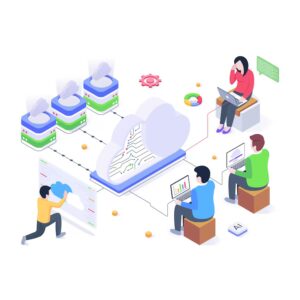Home Case Study Enhancing Model Deployment Efficiency with DevOps and Automation
TECHNOLOGY & SOFTWARE
Enhancing Model Deployment Efficiency with DevOps and Automation

Focus Areas
Model Deployment Automation
Operational Efficiency
Infrastructure as Code (IaC)

Business Problem
A SaaS company integrating AI-powered analytics into its platform struggled to efficiently deploy machine learning models to production. The process was manual, error-prone, and lacked standardization. Frequent delays, mismatched environments, and inconsistent configurations hampered performance and scalability. The company needed an automated, secure, and scalable way to deploy models seamlessly across development, staging, and production environments.
Key challenges:
Manual Model Deployment: Scripts and Jupyter notebooks were used to deploy models, leading to frequent errors.
Inconsistent Environments: Discrepancies between dev and prod environments resulted in unpredictable model behavior.
Slow CI/CD Integration: ML model deployment was disconnected from application CI/CD pipelines.
Limited Monitoring: Inadequate logging and metrics prevented insight into model performance and drift.
Security Gaps: Unsecured secrets, unclear access controls, and unverified model sources presented risks.
The Approach
Curate partnered with the company to implement a standardized MLOps pipeline leveraging DevOps principles. The goal was to automate model deployment, ensure reproducibility, and integrate monitoring and governance into the end-to-end ML lifecycle.
Key components of the solution:
Discovery and Requirements Gathering:
Model Lifecycle Review: Assessed current model training, validation, and deployment workflows.
Toolchain Assessment: Evaluated the use of MLflow, Docker, Jupyter, and custom deployment scripts.
Environment Review: Mapped infrastructure, cloud usage, and dependencies across teams.
Security and Compliance Audit: Identified gaps in secrets management, RBAC, and data usage controls.
Solution Design and Implementation:
CI/CD for ML Models:
Integrated model builds and validation steps into GitHub Actions pipelines.
Packaged models using Docker and published to secure artifact repositories.
Model Deployment Automation:
Used Terraform and Kubernetes to automate infrastructure provisioning.
Adopted Argo Workflows and MLflow for orchestrated model deployment and tracking.
Infrastructure as Code:
Rebuilt environments with Terraform modules for reproducibility.
Used Helm charts for deploying ML services across environments.
Security and Compliance:
Integrated Vault and Kubernetes secrets for model credentials.
Enforced signed containers and restricted model registry access.
Monitoring and Observability:
Deployed Prometheus and Grafana dashboards for model latency, throughput, and error tracking.
Integrated drift detection and shadow deployments for safe updates.
Process Optimization and Change Management:
Version Control: Enforced Git-based versioning for models, configs, and infrastructure.
Governance: Implemented audit logs for model changes and deployment history.
Team Enablement: Delivered training on model versioning, pipeline usage, and monitoring tools.
Change Review: Added approval workflows and PR templates for model deployment changes.
Business Outcomes
Security and Compliance
Policy-driven controls, encrypted secrets, and container security scans improved the compliance posture.
Improved Monitoring and Governance
Teams gained real-time visibility into model performance and could detect issues before users were affected.
Sample KPIs
Here’s a quick summary of the kinds of KPI’s and goals teams were working towards**:
| Metric | Before | After | Improvement |
|---|---|---|---|
| Model deployment time | 2 days | 30 minutes | 97% faster |
| Model rollback time | 3 hours | 10 minutes | 95% faster |
| Drift incident resolution time | 6 hours | 30 minutes | 92% improvement |
| Security incidents related to secrets | 4/month | 0/month | 100% reduction |
| Deployment failures | 22% | 4% | 82% reduction |
Customer Value
Agility at Scale
Enabled rapid iteration and testing of new ML models.
Secure AI Delivery
Protected models and data with integrated security controls.
Sample Skills of Resources
MLOps Engineers: Built CI/CD pipelines and integrated model tracking.
DevOps Engineers: Managed IaC, Kubernetes, and pipeline infrastructure.
Security Engineers: Hardened model deployments and integrated policy enforcement.
Platform Engineers: Developed reusable Helm charts and pipeline templates.
Data Scientists: Collaborated on model packaging, testing, and monitoring.
Tools & Technologies
CI/CD Platforms: GitHub Actions, GitLab CI
MLOps: MLflow, Argo Workflows
IaC & Deployment: Terraform, Helm, Kubernetes
Monitoring & Alerting: Prometheus, Grafana, Sentry
Security: Vault, Trivy, Kyverno, OPA/Gatekeeper
Collaboration: Jira, Confluence, Notion

Conclusion
By aligning DevOps principles with the needs of AI model lifecycle management, the SaaS company achieved fast, secure, and scalable model deployments. Curate’s tailored MLOps solution helped unify development, deployment, and monitoring—empowering the business to iterate quickly, deliver reliably, and innovate responsibly in the age of AI.
All Case Studies
View recent studies below or our entire library of work

Enhancing Model Deployment Efficiency with DevOps and Automation
TECHNOLOGY & SOFTWARE Enhancing Model Deployment Efficiency with DevOps and Automation Focus Areas Model Deployment Automation Operational Efficiency Infrastructure as Code (IaC) Business Problem A

Enhancing Kubernetes Cluster Monitoring with Custom Visualization Tools
Technology & Software Enhancing Kubernetes Cluster Monitoring with Custom Visualization Tools Focus Areas Kubernetes Monitoring Custom Dashboards Observability and Alerting Business Problem A rapidly growing

Optimizing Infrastructure with DevOps and Automation for a Technology Firm
TECHNOLOGY & SOFTWARE Optimizing Infrastructure with DevOps and Automation for a Technology Firm Focus Areas Infrastructure as Code (IaC) DevOps Enablement Automation Strategy Business Problem

Curate Supports Healthcare Company in Building a Dynamic Consumer Data Application
Healthcare case study Curate supports healthcare company in building a dynamic consumer data application. How a leading national healthcare company consolidated disparate consumer engagement data